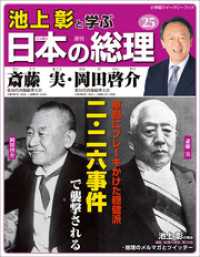- ホーム
- > 洋書
- > 英文書
- > Philosophy
Full Description
The period of Kierkegaard's life corresponds to Denmark's "Golden Age," which is conventionally used to refer to the period covering roughly the first half of the nineteenth century, when Denmark's most important writers, philosophers, theologians, poets, actors and artists flourished. Kierkegaard was often in dialogue with his fellow Danes on key issues of the day. His authorship would be unthinkable without reference to the Danish State Church, the Royal Theater, the University of Copenhagen or the various Danish newspapers and journals, such as The Corsair, Fædrelandet, and Kjøbenhavns flyvende Post, which played an undeniable role in shaping his development. The present volume features articles that employ source-work research in order to explore the individual Danish sources of Kierkegaard's thought. The volume is divided into three tomes in order to cover the different fields of influence. Tome III is dedicated to the diverse Danish sources that fall under the rubrics "Literature, Drama and Aesthetics." The Golden Age is known as the period when Danish prose first established itself in genres such as the novel; moreover, it was also an age when some of Denmark's most celebrated national poets flourished. Accordingly, this tome contains articles on Kierkegaard's use of the great Danish poets and prose writers, whose works are frequently quoted and alluded to throughout his writings. Kierkegaard regularly attended dramatic performances at Copenhagen's Royal Theater, which was one of Europe's leading playhouses at the time. In this tome his appreciation for the art of Denmark's best-known actors and actresses is traced. Finally, this tome features articles on the leading literary critics and aesthetic theorists of the Golden Age, who served as foils for Kierkegaard's own ideas.
Contents
Contents: Hans Christian Andersen: Andersen was just an excuse, Lone Koldtoft; Jens Baggesen: Kierkegaard and his master's voice, Henrik Blicher; Steen Steensen Blicher: the melancholy poet of the Jutland heath, Sven Hakon Rossel; August Bournonville: leap of faith and the 'noble art of Terpsichore', Nathaniel Kramer; Mathilde Fibiger: Kierkegaard and the emancipation of women, Katalin Nun; Meïr Goldschmidt: the cross-eyed hunchback, Johnny Kondrup; Thomasine Gyllembourg: Kierkegaard's appreciation of the everyday stories and Two Ages, Katalin Nun; Johan Ludvig Heiberg: Kierkegaard's use of Heiberg as a literary critic, George Pattison; Johanne Luise Heiberg: an existential actress, Katalin Nun; Carsten Hauch: a map of mutual misreadings, Poul Houe; Johan Nicolai Madvig: the master of Latin in Kierkegaard's Parnassus, Jesper Eckhardt Larsen; Christian Molbech: proverbs and punctuation: the inspiration of a Danish philologist, Kim Ravn; Peter Ludwig Møller: 'If he had been a somewhat more significant person...', K. Brian Söderquist; Adam Oehlenschläger: Kierkegaard and the treasure hunter of immediacy, Bjarne Troelsen; Joachim Ludvig Phister: the great comic actor of reflection and thoughtfulness, William Banks; Christian Winther: Kierkegaard as lover and reader, Nathaniel Kramer; Indexes.
-

- 電子書籍
- 中園家のお気に入り【単話】(4) Me…
-

- 電子書籍
- 愛されてる場合じゃないの 31話「夜這…
-

- 電子書籍
- 愛されていた記憶【タテヨミ】第16話 …
-

- 電子書籍
- ガヴリールドロップアウト【分冊版】 4…
-

- 電子書籍
- 池上彰と学ぶ日本の総理 第25号 斎藤…



